High-sided dishes, also known as scoop plates or plate guards, represent one of the most transformative adaptive dining solutions for elderly individuals struggling with mealtime independence.
These specialized plates feature raised edges that typically range from 1 to 2 inches in height, creating a protective barrier that prevents food from sliding off the plate.
For seniors dealing with tremors, limited hand-eye coordination, stroke recovery, or vision impairments, high-sided dishes can mean the difference between frustrating mealtimes and dignified, independent dining.
Unlike standard plates with minimal or gently curved edges, high-sided dishes have substantially raised walls, sometimes nearly vertical, that keep food contained even when scooping becomes imprecise or hand movements are unsteady.
This simple yet ingenious design modification addresses multiple challenges that elderly diners face, from physical limitations to psychological barriers around eating.
In this comprehensive guide, we’ll explore everything you need to know about high-sided dishes: how they work, who benefits most, key features to look for, and how to select the perfect option for specific conditions and needs.
What Are High-Sided Dishes and How Do They Work?
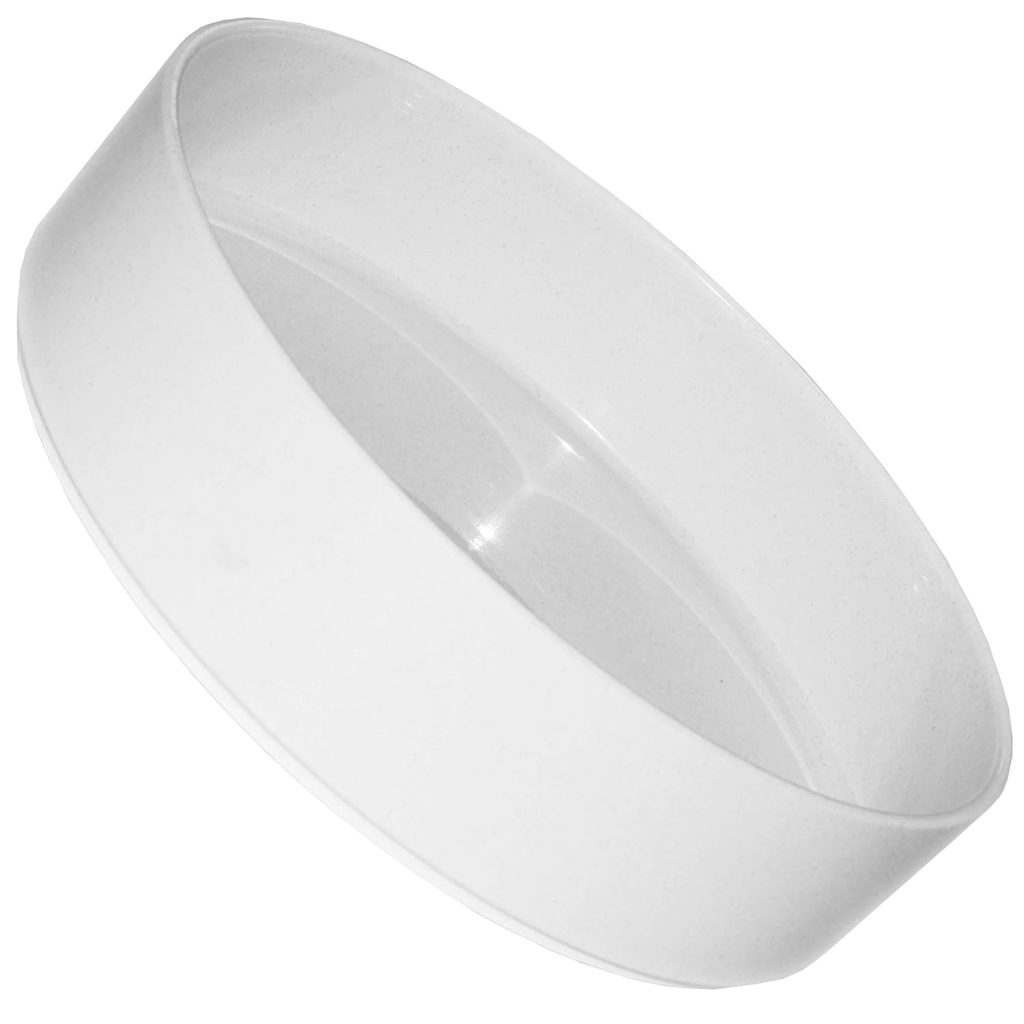
High-sided dishes are adaptive plates specifically designed with elevated edges that create a bowl-like containment system while maintaining the flat eating surface of a traditional plate.
The raised walls typically measure between 1 and 2 inches high and can run continuously around the entire perimeter or feature a strategically lower section on one side to facilitate easier scooping.
The Design Philosophy
The concept behind high-sided dishes is elegantly simple: by adding vertical or near-vertical walls around a plate’s edge, food naturally stays within the eating area regardless of imprecise utensil movements, tremors, or limited motor control.
This physical barrier acts as a “safety net” that compensates for various physical challenges without requiring the user to change their eating technique dramatically.
Some high-sided dishes feature a continuous raised edge all around, providing maximum containment from every angle.
Others incorporate what’s called a “scoop side”—a lower section (usually opposite the user’s dominant hand) that makes it easier to push food onto utensils by providing less resistance at the loading point while maintaining high sides everywhere else for containment.
The Mechanics of Easier Eating
When an elderly person uses a high-sided dish, the raised edge provides crucial resistance against which food can be pushed.
This is particularly valuable for one-handed eaters who cannot stabilize their plate with a second hand.
Instead of food sliding around a flat surface as the fork or spoon approaches, the high side stops the food’s movement, allowing it to be scooped up efficiently.
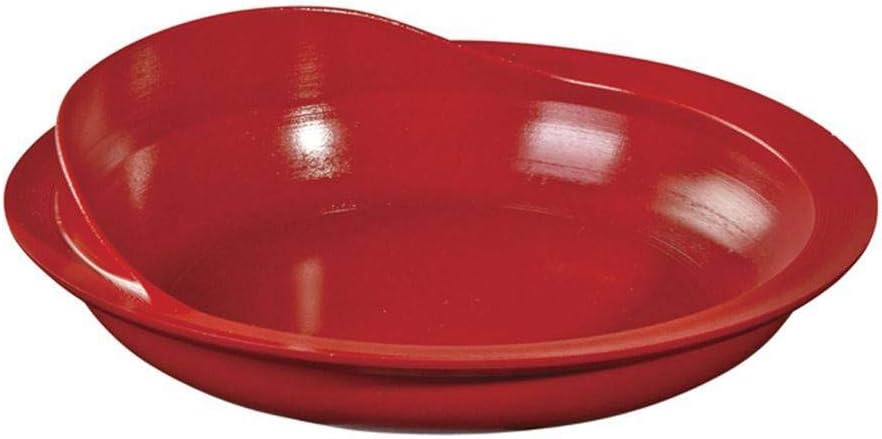
For individuals with tremors or unsteady hands, the high sides catch food that would otherwise fall off a regular plate when utensils miss their mark or when hands shake during the transfer from plate to mouth.
This containment system dramatically reduces food waste, table mess, and the emotional distress that often accompanies difficult mealtimes.
Why High-Sided Dishes Help Elderly Users
The benefits of high-sided dishes extend far beyond simple spill prevention. These adaptive plates address physical, psychological, and practical challenges that impact elderly dining experiences:
Prevents Food Spillage and Waste
For elderly individuals with tremors, reduced hand-eye coordination, or neurological conditions like Parkinson’s disease, the high sides act as an effective safety barrier.
When utensils miss the target or when scooping becomes imprecise due to shaking hands, the raised edge keeps food on the plate rather than on the table, lap, or floor.
This prevents food waste, reduces cleaning burden, and eliminates the frustration of watching meals literally fall away.
Facilitates One-Handed Eating
Many stroke survivors experience hemiplegia (paralysis on one side of the body) or significant weakness that makes using both hands impossible.
High-sided dishes provide the resistance that a second hand would normally offer. Users can push food against the raised edge and scoop it onto a fork or spoon using just their functional hand.
Without this feature, food would simply slide around a flat plate, making independent eating nearly impossible.
Makes Scooping Significantly Easier
The vertical or near-vertical walls transform the scooping action from a challenging pursuit across a flat surface into a simple push-and-lift motion.
This is particularly helpful for individuals with arthritis who have limited wrist mobility and cannot perform the complex rotation movements required to chase food around a regular plate.
Foods like peas, rice, corn, and other small items that typically escape regular plates are easily corralled by high sides.
Builds Confidence and Preserves Dignity
Mealtime struggles can be profoundly demoralizing for elderly individuals who value their independence.
The anxiety of making a mess, needing help, or appearing incompetent in front of family or caregivers can actually suppress appetite and lead to poor nutrition.
High-sided dishes remove this anxiety by virtually guaranteeing mess-free eating, allowing users to focus on enjoying their meal rather than worrying about performance.
This psychological benefit often translates into improved appetite, better nutrition, and enhanced quality of life.
Supports Visual Impairments
For seniors with low vision, macular degeneration, diabetic retinopathy, or other visual impairments, the distinct raised edge provides crucial tactile feedback.
Users can feel where their plate ends by touching the raised wall with their utensils or fingers, helping them navigate their food more confidently.
This sensory information reduces the likelihood of utensils sliding off the edge and helps users understand the spatial layout of their meal.
Reduces Caregiver Burden
While the primary focus is on user independence, high-sided dishes also significantly reduce the workload for caregivers and family members.
Less mess means less cleanup time, fewer clothing changes, and reduced stress for everyone involved in mealtimes.
This practical benefit makes high-sided dishes valuable even for users who receive dining assistance.
Comparing High-Sided Dishes to Other Adaptive Plates
Understanding how high-sided dishes compare to alternative adaptive dining solutions helps in making informed choices:
High-Sided Dishes vs. Plate Guards
Plate guards are removable clips or rings that attach to regular plates to create a temporary raised edge.
While these offer portability and versatility, integrated high-sided dishes provide superior stability, eliminate gaps where food can escape, and don’t risk slipping or detaching during vigorous use.
High-sided dishes are also fully dishwasher-safe without disassembly and present a more normalized appearance.
High-Sided Dishes vs. Divided Plates
Divided adaptive plates feature compartments to separate different foods, but often have relatively low dividing walls.
High-sided dishes with divisions offer the best combination—food separation for picky eaters or portion control, plus substantial edge height for maximum containment and scooping assistance.
High-Sided Dishes vs. Scoop Bowls
While scoop bowls have curved sides that help with food loading, high-sided plates provide a flatter, wider eating surface that’s more familiar to users and better suited for foods like meat, sandwiches, or items that benefit from a cutting surface.
High-sided plates feel more like traditional dining while offering similar functional benefits.
Key Features to Look for in High Side Dish
When selecting high sided dishes for elderly users, evaluate these critical characteristics:
Edge Height
The effectiveness of a high-sided dish depends largely on its wall height. Look for sides that are at least 1.5 inches high for maximum effectiveness.
Some models offer up to 2-inch sides for users with more significant motor control challenges or very vigorous eating movements.
However, excessively high sides (over 2 inches) can make it difficult to see or reach food.
Base Stability
Non-slip bases or suction cup bottoms are essential, particularly for one-handed users who cannot steady the plate with their other hand.
Rubberized bases, silicone pads, or suction mechanisms prevent the plate from sliding during aggressive scooping or when pushed against by utensils.
Test the stability by attempting to slide the plate across different surfaces—it should resist movement significantly.
Material Quality
Food-grade melamine or BPA-free plastic options are lightweight and virtually unbreakable—ideal for users with grip issues, tremors, or cognitive decline that might lead to dropped plates.
These materials typically handle microwave and dishwasher use well.
Ceramic or stoneware options provide a more traditional, dignified dining experience and excellent weight for stability, though they’re heavier to lift and can break if dropped.
Choose these for users with adequate strength and coordination.
Stainless steel high-sided dishes are durable and institutional-grade, but can be cold to the touch and may not be microwave-safe.
Inner Lip Design
The best high sided dishes feature a slightly curved or angled inner lip that guides food toward the center of the plate rather than trapping it in corners where it’s difficult to reach.
This thoughtful design detail makes the scooping action even more efficient and prevents food from getting stuck along the edges.
Size and Capacity
Choose plates that are large enough for a full meal—typically 9 to 10 inches in diameter—but not so large that they become unwieldy or difficult for elderly users to manage.
The plate should fit comfortably on standard tables and trays while providing adequate space for a balanced meal with proteins, vegetables, and starches.
Weight Balance
The plate should be heavy enough to remain stable during use but light enough for elderly users to lift comfortably when necessary (when passing to caregivers, moving from tray to table, etc.).
Generally, empty plates should weigh between 8-14 ounces—substantial enough for stability but manageable for weakened hands.
Microwave and Dishwasher Safety
Ensure the high-sided dish can withstand regular cleaning and reheating without warping, degrading, or leaching chemicals. Look for products explicitly labeled as microwave and dishwasher-safe.
This practical feature reduces caregiver burden and ensures the plate can be used daily without special care requirements.
Aesthetic Considerations
While functionality is paramount, appearance matters for elderly dignity and acceptance.
Choose high-sided dishes that look as similar to regular dinnerware as possible, with attractive colors and finishes rather than institutional or medical appearances.
Elderly users are more likely to embrace adaptive equipment that doesn’t look overly “special needs.”
Best High-Sided Dishes for Specific Conditions
Different conditions benefit from specific design features:
For Parkinson’s Disease or Essential Tremor
Select high-sided dishes with extra-deep walls (1.75 to 2 inches) and heavy-duty suction or weighted bases to accommodate significant involuntary movements.
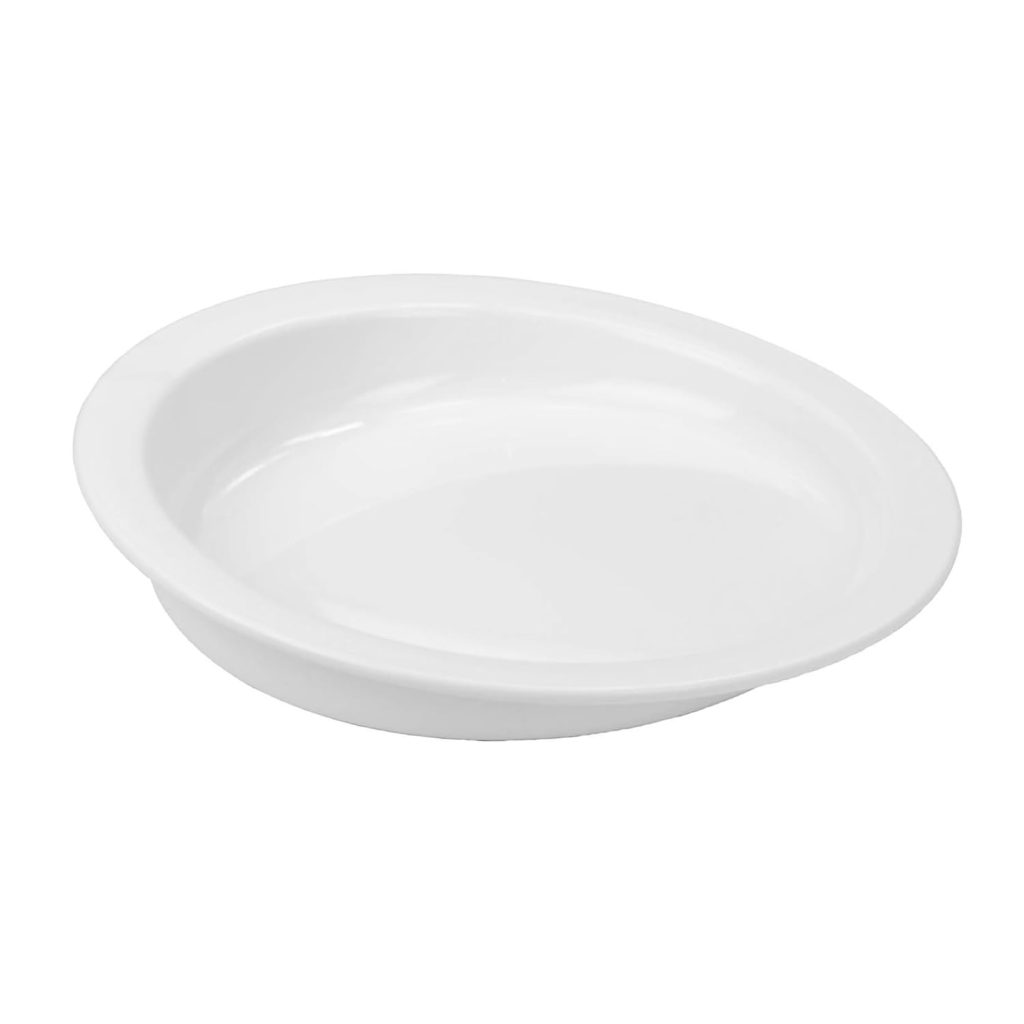
The Medline Scooper Plate and Sammons Preston Independence Plate feature these specifications and have proven track records with Parkinson’s patients.
For Stroke Recovery and One-Handed Eating
Look for high-sided dishes with a lower “scoop section” on one side, often called scoop plates.
These designs make one-handed eating significantly easier by reducing resistance on the loading side while maintaining high containment walls on the other three sides.
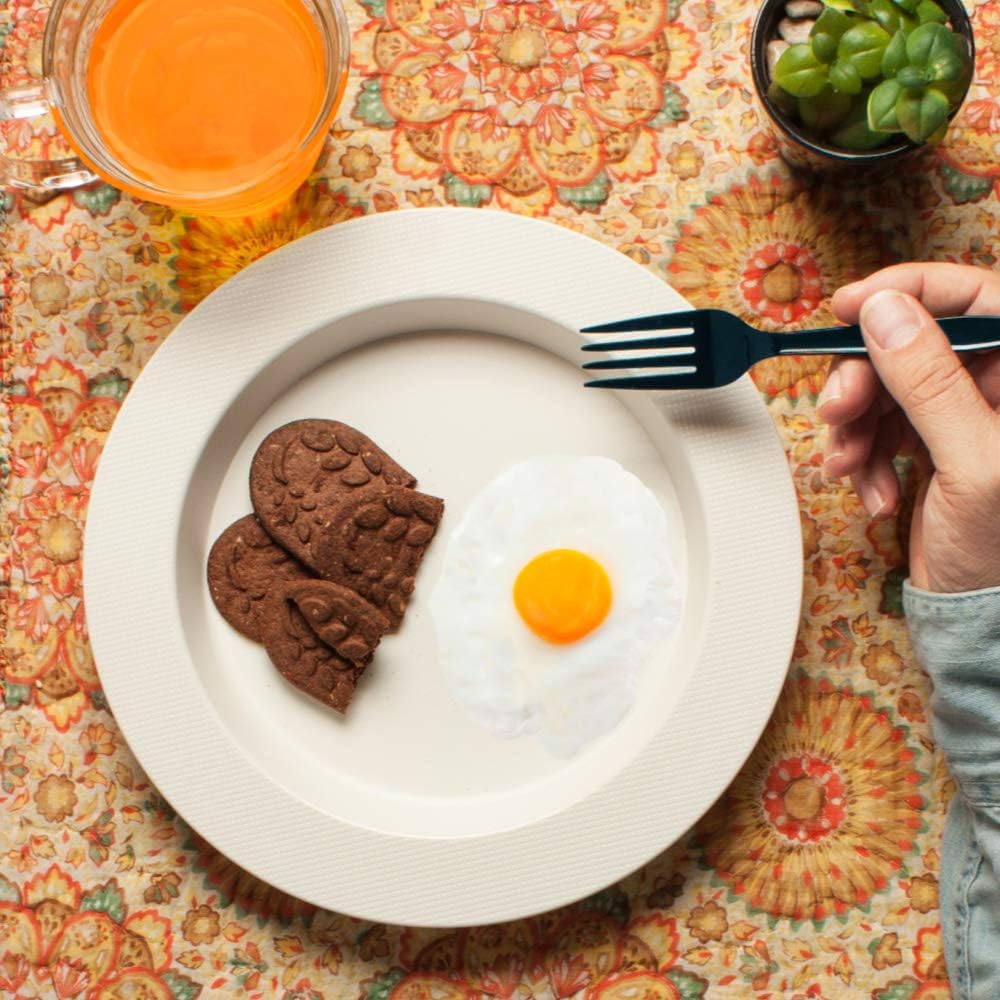
The Ableware Scooper Plate is specifically designed for hemiplegic users and features this configuration.
For Arthritis
Choose lightweight plastic or melamine high-sided dishes with smooth, rounded edges that won’t strain weak or painful joints.
Avoid heavy ceramic options that require more grip strength to handle.
Look for models under 10 ounces empty weight with ergonomic designs that minimize lifting and handling requirements.
For Dementia or Alzheimer’s
High contrast colors help users with cognitive decline distinguish their plate from the table and maintain focus on eating.
Red or blue high-sided plates against white or light-colored tablecloths improve visibility and encourage eating by making the meal more visually obvious.
Simple, solid colors without busy patterns reduce confusion.
For Low Vision or Blindness
Textured or brightly colored high-sided dishes with distinct, consistent tactile edges help visually impaired seniors navigate their food confidently.
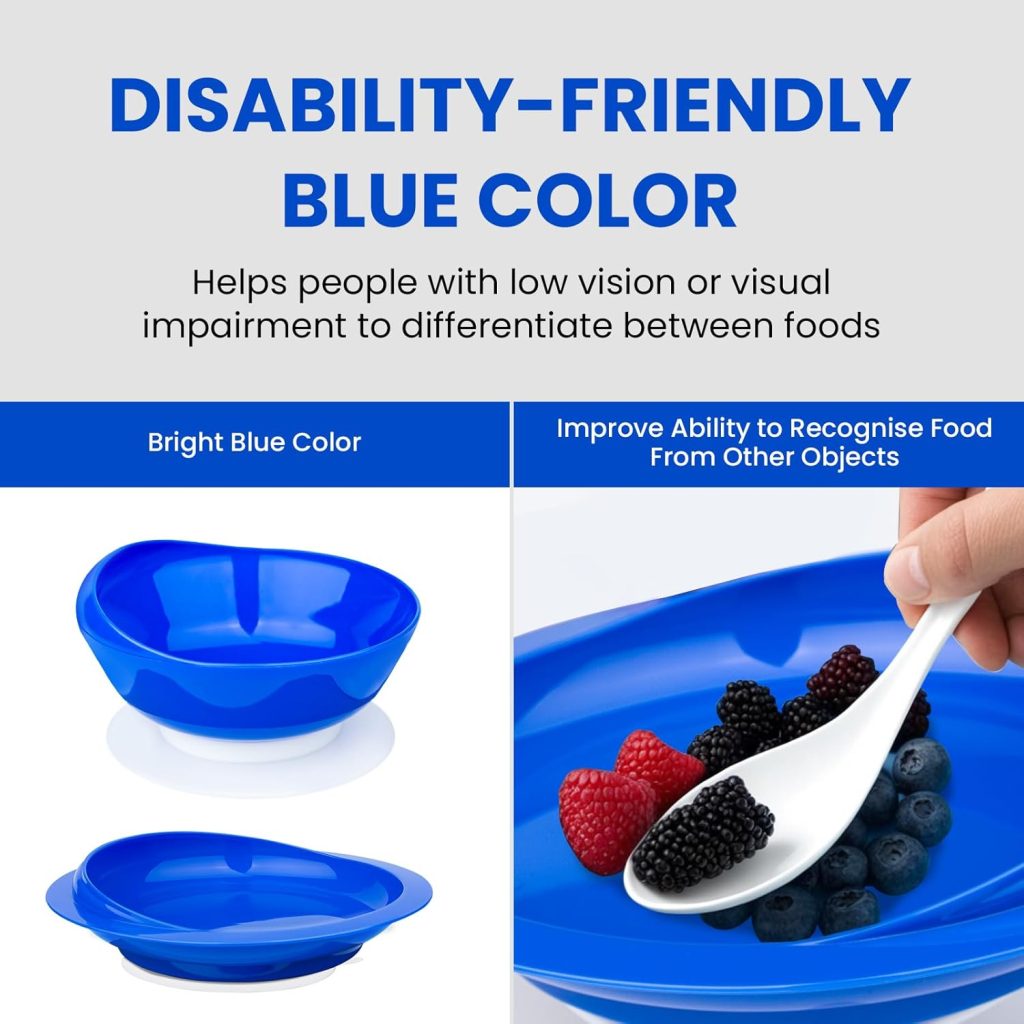
The raised sides provide essential sensory feedback that compensates for visual limitations.
Consider plates with inner rim color contrast for additional visual cues for those with partial vision.
Tips for Introducing High Side Dish Successfully
Some elderly individuals may initially resist adaptive equipment, viewing it as a sign of declining independence or an admission of disability.
Here’s how to introduce high-sided dishes in a positive, accepting way:
Frame It as Convenience, Not Disability
Present the high-sided dish as a practical, modern convenience that makes dining easier and more enjoyable, similar to other helpful kitchen tools everyone uses.
Avoid medical or clinical language. Instead of saying “You need this because you’re having trouble,” try “I found this great plate that keeps food in place—I think you’ll really enjoy using it.”
Start Gradually
Introduce the high-sided dish for messier foods first—soups, stews, rice dishes, pasta, or foods with sauces that tend to spill.
As the user experiences success and reduced stress with these meals, gradually expand use to all meals. This incremental approach builds confidence and acceptance.
Maintain Familiar Routines
Keep other aspects of mealtime completely consistent: same table setting, same timing, same favorite foods, same dining location.
Make the plate the only change so it doesn’t feel like a wholesale transformation of the dining experience. Familiar routines reduce resistance to new equipment.
Emphasize Cleanliness and Ease
Many seniors appreciate practical benefits. Frame the high-sided dish as something that “keeps the table cleaner,” “makes eating easier,” or “reduces laundry” rather than focusing on the user’s limitations.
These positive, practical benefits feel less threatening than discussing physical decline.
Model Usage
If possible, use high-sided dishes yourself or have other family members use them during shared meals.
When adaptive equipment becomes “family equipment” rather than “special equipment,” acceptance typically increases dramatically.
Offer Choice
Present several high-sided dish options in different colors or styles and allow the elderly person to choose their favorite.
This preserves autonomy and creates buy-in through personal preference rather than imposed solutions.
Care and Maintenance
Proper care extends the life and effectiveness of high-sided dishes:
Daily Cleaning
Most plastic and melamine high-sided dishes are dishwasher safe on the top rack, though hand washing with warm, soapy water and a soft sponge extends their lifespan by preventing gradual degradation from harsh dishwasher detergents and high heat.
Avoid Abrasive Cleaners
Don’t use steel wool, abrasive scrubbers, or harsh chemical cleaners that might scratch surfaces or remove non-slip coatings.
Scratches can harbor bacteria and compromise hygiene. Stick with soft cloths or sponges and gentle dish soap.
Check Suction Cups Regularly
If your high-sided dish features suction cups or non-slip bases, inspect them regularly for wear, cracks, or reduced effectiveness.
Clean suction cups with rubbing alcohol periodically to maintain grip. Replace plates when the base becomes less effective at preventing sliding.
Inspect for Damage
Regularly check for cracks, chips, or degradation, particularly along the high sides where stress concentrates.
Even small cracks can harbor bacteria and compromise food safety. Replace damaged dishes promptly rather than continuing to use compromised equipment.
Storage Considerations
Store high-sided dishes where they’re easily accessible to reduce the temptation to use regular plates instead. If the adaptive plate is convenient to grab, it’s more likely to be used consistently.
Conclusion
High-sided dishes represent one of the most practical, immediately effective adaptive solutions for elderly dining challenges.
By providing a simple physical barrier around the eating surface, they restore independence, reduce mealtime stress and mess, and help seniors maintain the dignity and pleasure of eating without constant assistance.
Whether addressing tremors from Parkinson’s disease, one-handed limitations from stroke, visual impairments, arthritis, or general age-related decline in coordination, high-sided dishes offer a non-intrusive solution that preserves normalcy while dramatically improving function.
When selected thoughtfully based on individual needs and introduced with sensitivity, these adaptive plates can transform frustrating mealtimes into dignified, independent experiences that support better nutrition and enhanced quality of life for elderly individuals.